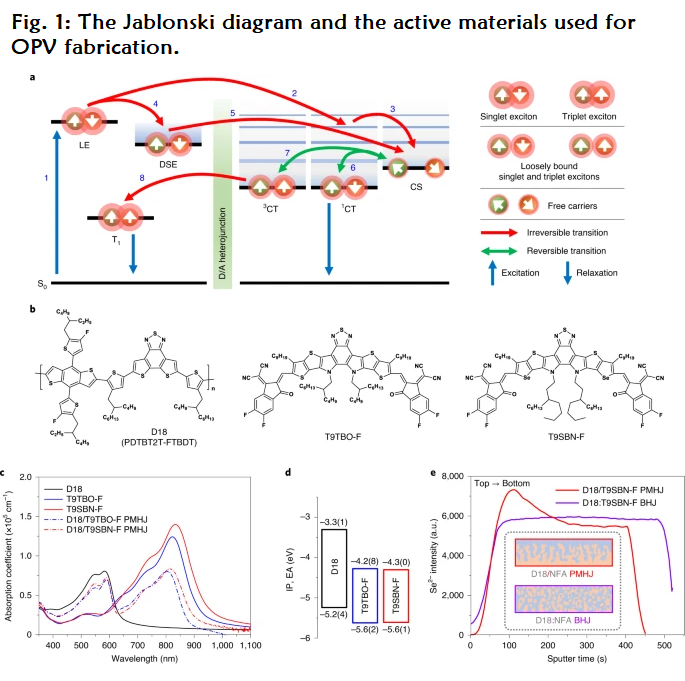
Published on nature energy (14 November 2022)
Author(s): Kui Jiang, Jie Zhang, Cheng Zhong, Francis R. Lin, Feng Qi, Qian Li, Zhengxing Peng, Werner Kaminsky, Sei-Hum Jang, Jianwei Yu, Xiang Deng, Huawei Hu, Dong Shen, Feng Gao, Harald Ade, Min Xiao, Chunfeng Zhang, Alex K.-Y. Jen
Abstract
At present, high-performance organic photovoltaics mostly adopt a bulk-heterojunction architecture, in which exciton dissociation is facilitated by charge-transfer states formed at numerous donor–acceptor (D-A) heterojunctions. However, the spin character of charge-transfer states originated from recombination of photocarriers allows relaxation to the lowest-energy triplet exciton (T1) at these heterojunctions, causing photocurrent loss. Here we find that this loss pathway can be alleviated in sequentially processed planar–mixed heterojunction (PMHJ) devices, employing donor and acceptor with intrinsically weaker exciton binding strengths. The reduced D-A intermixing in PMHJ alleviates non-geminate recombination at D-A contacts, limiting the chance of relaxation, thus suppressing T1 formation without sacrificing exciton dissociation efficiency. This resulted in devices with high power conversion efficiencies of >19%. We elucidate the working mechanisms for PMHJs and discuss the implications for material design, device engineering and photophysics, thus providing a comprehensive grounding for future organic photovoltaics to reach their full promise.

a, Illustration of excited-state dynamics in OPV: (1) photoexcitation of singlet excitons: S0→LE; (2, 4) transfer pathways of photoexcited singlet excitons: LE→1CT (2) and LE→DSE (4); (3, 5) dissociation of loosely bound singlet excitons into free charges: 1CT→CS (3) or DSE→CS (5); (6, 7) CT states formation through non-geminate recombination: CS→1CT/3CT, possibly with 1CT/3CT→CS repopulation and spin-allowed 1CT→S0 relaxation; (8) 3CT→T1 relaxation, where further T1→S0 relaxation can happen via triplet-charge annihilation, leading to permanent loss of photocarriers. b, Molecular structures of D18 and two major NFAs used in this study. c, Thin-film optical absorption of D18, NFAs and D18/NFA PMHJ blends. d, Energy level diagram of materials (IP: ionization potential corresponding to the highest occupied molecular orbital energy level; EA: electron affinity corresponding to the lowest unoccupied molecular orbital energy level.). e, ToF-SIMS Se2? ion yield of D18/T9SBN-F PMHJ and D18:T9SBN-F BHJ blends plotted over sputtering time. The inset shows the schematic illustration of PMHJ and BHJ blends.
Read more: https://www.nature.com/articles/s41560-022-01138-y#Fig1